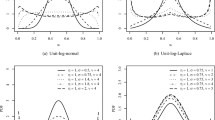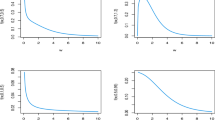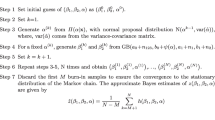Abstract
The considered problem can be treated as a particular topic in the field of testing some substantive hypothesis in financial auditing. The main theme of the paper is the well-known problem of testing hypothesis on admissibility of the population total of accounting errors amounts. The set of items with non-zero errors amounts is the domain in the accounting population. The book amounts are treated as values of a random variable which distribution is a mixture of the distributions of correct amount and the distribution of the true amount contaminated by error. The mixing coefficient is equal to the proportion of the items with non-zero errors amounts. The mixture of two gamma distributions is taken into account. The well-known method of moments and likelihood method are proposed to estimate parameters of distribution. It let us construct some statistic to test the outlined hypothesis. Moreover, the well-known likelihood ratio test is considered.
Similar content being viewed by others
References
Cassel, C.M., Särndal, C.E. and Wretman, J.H. (1977). Foundation of Inference in Survey Sampling. Wiley, New York.
Chen, J., Chen, S.Y. and Rao, J.N.K. (1998). Empirical likelihood confidence intervals for the mean of a population containing many zero values. The Canadian Journal of Statistics 31, 1, 53–68.
Cox, D.R. and Snell, E.J. (1979). On sampling and the estimation of rare errors. Biometrika 66, 1, 125–132. Errata: Biometrika 69(2), 491 (1982).
Cramér, H. (1962). Mathematical Methods of Statistics. Asia Publishing House, Bombay.
Dimitrov, B., Green, D. Jr., Rykov, V. and Stanchev, P. (2003). On statistical hypothesis testing via simulation method. International Journal of Information Theories and Applications 10, 408–414.
Davison, A.C. and Hinkley, D.V. (1997). Bootstrap Methods and Their Applications. Cambridge University Press, Cambridge.
Dufour, J.M. (2006). Monte Carlo tests with nuisance parameters: A general approach to finite-sample inference and nonstandard asymptotics. Journal of Econometrics 133, 443–477.
Dufour, J.M. and Khalaf, L. (2001). Monte Carlo test methods in econometrics, Oxford, Baltagi, B. (ed.), p. 494–519.
Fienberg, S.E., Nether, J. and Leitch, R.A. (1977). Estimating the total overstatement error in accounting populations. Journal of the American Statistical Association 72, 295–302.
Frost, P.A. and Tamura, H. (1986). Accuracy of auxiliary information interval estimation in statistical auditing. Journal of Accounting Research 24, 57–75.
Ghosh, M. and Meeden, G. (1997). Bayesian Methods for Finite Population Sampling. Chapman & Hall, London.
Guy, D.M. and Carmichael, D.R. (1986). Audit sampling: An introduction to statistical sampling in auditing. Wiley, New York.
Hall, P. (1992). The Bootstrap and Edgewrth Expansion. Springer-Verlag, New York.
Kvanli, A.H., Shen, Y.K. and Deng, L.Y. (1998). Construction of confidence intervals for the mean of a population containing many zero values. Journal of Business and Economic Statistics 16, 362–368.
MacKinnon, J. (2007). Bootstrap hypothesis testing. Queen’s Economics Department, Working Paper no 1127.
Marazzi, A. and Tillé, Y. (2016). Using past experience to optimize audit sampling design. Review of Quantive Finance Accounting 1-28, https://doi.org/10.1007/s11156-016-0596-7.
McLachlan, G. and Peel, D. (2000). Finite Mixture Models. Wiley, New York.
Meng, X.L. (1977). The EM algorithm and medical studies: A historical link. Statistical Research Methods in Medical Research 6, 3–23.
Silvey, S.D. (1959). The Lagrangian multiplier test. The Annals of Mathematical Statistics 30, 2, 389–407.
Särndal, C.-E., Swensson, B. and Wretman, J. (1989). Statistical models and analysis in auditing. Panel on nonstandard mixtures of distributions. Statistical Science 4, 1, 2–33.
Tamura, H. (1988). Estimation of rare errors using judgement. Biometrika 75, 1–9.
Wywiał, J.L. (2016). Contributions to Testing Statistical Hypotheses in Auditing. PWN, Warsaw.
Funding
The project is supported by the grant of the National Science Centre, Poland, DEC-2012/07/B/HS4/03073.
Author information
Authors and Affiliations
Corresponding author
Rights and permissions
About this article
Cite this article
Wywiał, J.L. Application of Two Gamma Distributions Mixture to Financial Auditing. Sankhya B 80, 1–18 (2018). https://doi.org/10.1007/s13571-018-0154-5
Received:
Published:
Issue Date:
DOI: https://doi.org/10.1007/s13571-018-0154-5
Keywords and phrases
- Statistical auditing
- Accounting error
- Mixture of probability distribution
- Method of moments
- Likelihood ratio test




